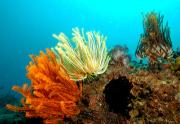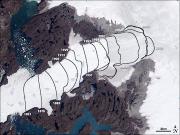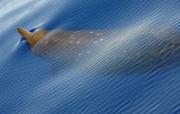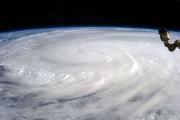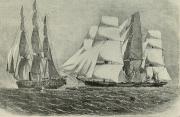Radio Program
Our regular Science and the SeaTM radio program presents marine science topics in an engaging two-minute story format. Our script writers gather ideas for the radio program from the University of Texas Marine Science Institute's researchers and from our very popular college class, Introduction to Oceanography, which we teach to hundreds of non-science majors at The University of Texas at Austin every year. Our radio programs are distributed at to commercial and public radio stations across the country.
If you happen to be snorkeling in the Indian Ocean some day and you come face to face with what looks like a feather duster, leave it in peace. It’s not trash; it’s a feather star -- a creature that’s related to sea stars.
Like a sea star, it has five arms. But the arms can have many branches -- up to 200 in all. And, the branches are covered with delicate appendages that make them look like feathers.
A glacier in Greenland has been moving at anything but glacial speeds in recent years. In the summer of 2012, it hit a top rate of 150 feet per day -- about 10 miles per year. As a result, it’s dumping more ice into the north Atlantic Ocean, and contributing to the rise in global sea level.
As the ocean tides slosh back and forth, they have several important effects. They help sculpt the coastline, for example, and they cause Earth’s rotation on its axis to slow down. And recent research has shown that the tides create a weak magnetic field. Scientists are using that field to study both the oceans and conditions deep inside our planet.
If whales had their own Olympic games, one of the events might be deep diving. And the gold medal would go to a species known as Cuvier’s whale. A few years ago, one member of the species was tracked to a depth of more than a mile, and it stayed underwater for more than two hours. That’s a record for any marine mammal.
Parts of the northern Atlantic Ocean have experienced a chilldown in recent years. In particular, a large pool of water between Canada and Europe has cooled by about three-quarters of a degree. And some researchers say that could lead to drier conditions across the Atlantic.
Loud music, roaring jet engines, heavy construction, and other piercing sounds are often described as “ear-splitting.” And that’s not far from the truth. They can destroy tiny hairs in the ear that detect sound waves, causing a hearing loss. And so far, there’s no way to repair the damage. But researchers have found some cause for hope in the tentacles of the sea anemone.
The most powerful tropical cyclone ever recorded slammed into the Philippines in November of 2013. Typhoon Haiyan packed sustained winds of 195 miles per hour — the strongest of any typhoon or hurricane ever recorded at landfall. Over a few days, as it roared across the islands and then into mainland Asia, it killed as many as 7500 people and caused billions of dollars in damages.
As science-fiction writers often remind us, life on Earth is based on carbon. The element is found in everything from proteins and carbohydrates to DNA — everything that makes it possible for life to move, eat, and reproduce.
Yet carbon isn’t something that we ingest directly — you can’t order a plate of charcoal at your favorite food trailer. Instead, carbon comes to us through plants and tiny plant-like organisms in the oceans, which get it from carbon dioxide in the atmosphere.
Atlantic cod was a mainstay of the New England economy for centuries. Commercial fleets brought in tens of thousands of tons of the tasty fish every year. A carved wooden cod was even placed in the Massachusetts House of Representatives.
But overfishing led to a collapse of the industry in the 1990s. And there’s been little rebound since then, despite stricter limits on annual catches. A recent study says that, in at least one region, that may be the result of warmer waters.
In “The Rime of the Ancient Mariner,” English poet Samuel Taylor Coleridge chronicles the adventures and misfortunes of a sailing vessel. Among the challenges was a time when the winds died, leaving the ship motionless, which the mariner describes like this:
Day after day, day after day,
We stuck, nor breath nor motion;
As idle as a painted ship
Upon a painted ocean.
The ship was stuck in the doldrums, a zone near the equator with little wind but frequent clouds and storms.

